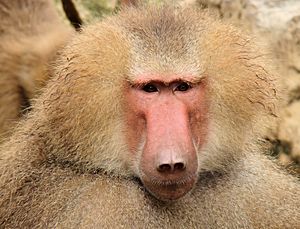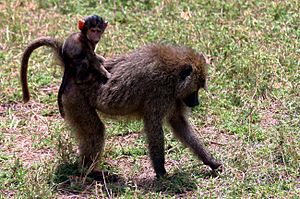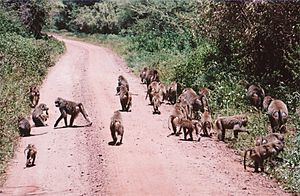Baboon facts for kids
Quick facts for kids Baboon |
|
|---|---|
 |
|
| Hamadryas baboon (Papio hamadryas) | |
| Scientific classification | |
| Kingdom: | |
| Phylum: | |
| Class: | |
| Order: | |
| Family: | |
| Genus: |
Papio
Erxleben, 1777
|
| Species | |
Baboons are large Old World monkeys that live in Africa and Arabia. There are five different types, or species, of baboons. They are some of the biggest monkeys in the world. Only the mandrill and the drill are larger than baboons.
Baboons come in different sizes. For example, the Guinea baboon is about 50 centimeters (20 inches) tall and weighs around 14 kilograms (31 pounds). The largest baboon, the chacma baboon, can be up to 120 centimeters (47 inches) tall and weigh 40 kilograms (88 pounds)!
Contents
What Do Baboons Look Like?

All baboons have long faces that look a bit like a dog's snout. They have strong jaws with sharp canine teeth. Their eyes are close together.
Most of their body is covered in thick fur, but their faces do not have much fur. They have short tails. Baboons also have special rough, hairless pads on their bottoms called ischial callosities. These pads help them sit comfortably.
Male and female baboons often look different. This is called sexual dimorphism. Males are usually bigger than females. Sometimes, they also have different fur colors or bigger canine teeth. For example, male Hamadryas baboons have a large white mane of fur around their heads and shoulders.
Where Baboons Live and What They Eat

Baboons live on the ground in open grasslands, woodlands, and hills across Africa. They are omnivores, which means they eat both plants and animals.
Their diet is mostly plants, but they also eat insects. Sometimes, they hunt and eat fish, shellfish, hares, birds, vervet monkeys, and small antelopes. Baboons spend their days looking for food. They can even raid human homes to find food. In some places, they have been known to eat sheep and goats.
In the wild, baboons usually live for about 30 years. In zoos, they can live much longer, sometimes up to 45 years!
Who Hunts Baboons?
Large predators like Nile crocodiles, lions, spotted and striped hyenas, leopards, and cheetahs hunt baboons. However, adult baboons can be tough prey. Leopards usually only hunt young baboons.
When a predator comes too close, large male baboons will often try to scare them away. They might flash their eyelids, show their teeth by yawning, screech loudly, or chase the predator. Sometimes, baboons can be killed by black mamba snakes if they accidentally disturb them.
How Baboons Live Together
Most baboons live in groups called "troops." These troops have a clear social order, like a hierarchy. The size of a troop can be anywhere from 5 to 250 baboons, but often it's around 50. The size depends on the type of baboon and the time of year.
Some baboons, like the Hamadryas baboons, live in very large groups made up of many smaller family units called "harems." Each harem usually has one male and a few females.
Baboons are very good at understanding who is in charge in their troop. They pay close attention to fights or arguments between different families. This helps them know how these conflicts might affect the whole troop.
In hamadryas baboon harems, the males are very protective of their females. They might even grab or bite females if they wander too far. Sometimes, other males try to steal females from a harem. This can lead to aggressive fights between the males. During these fights, males might show their teeth or make loud noises.
Baboon Babies

Female baboons usually give birth to one baby after about six months of pregnancy. A newborn baboon weighs around 400 grams (less than a pound) and has black skin.
Female baboons are the main caregivers for their young. However, several females in the troop might help care for all the babies. Young baboons drink their mother's milk for about one year. They become adults when they are about five to eight years old.
Male baboons usually leave their birth group before they become adults. Female baboons, however, often stay in the same group their entire lives.
Baboons and Humans
In ancient Egyptian mythology, the baboon was a sacred animal. The god Babi was shown as a hamadryas baboon. Baboons were also seen as helpers of the god Thoth, who was the god of writing and knowledge.
Images for kids
See also
 In Spanish: Papiones para niños
In Spanish: Papiones para niños







